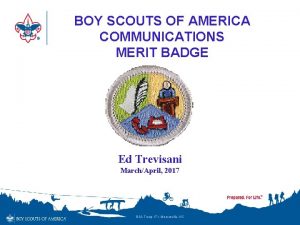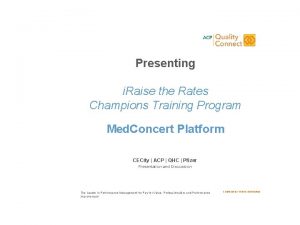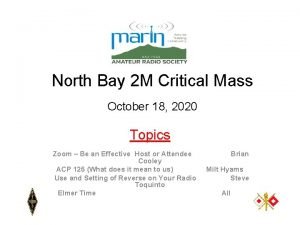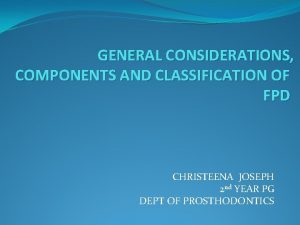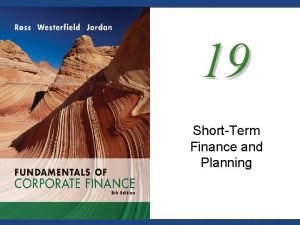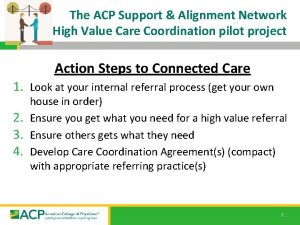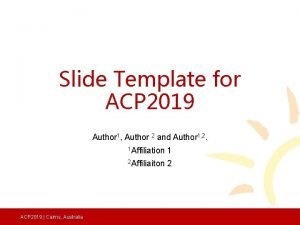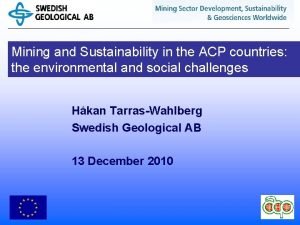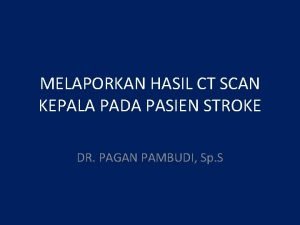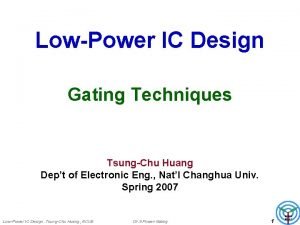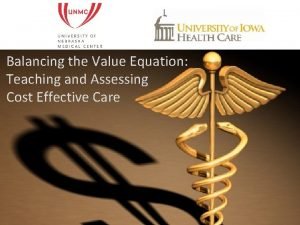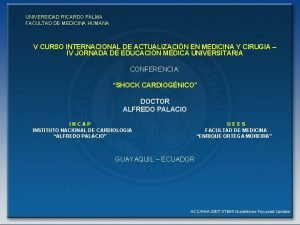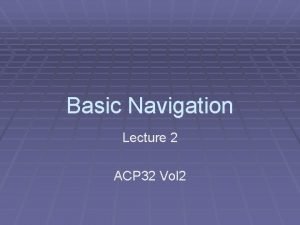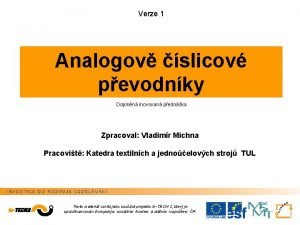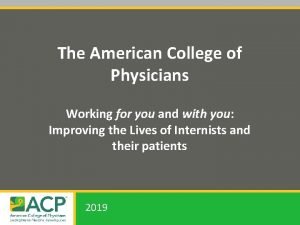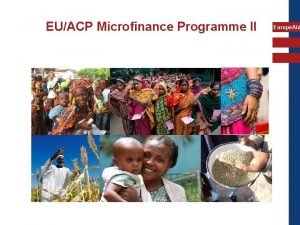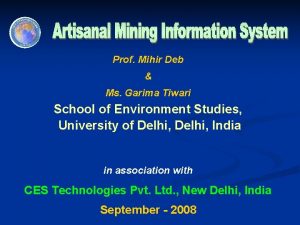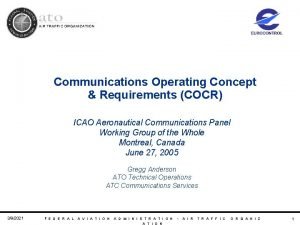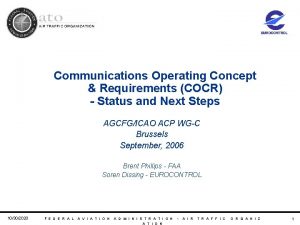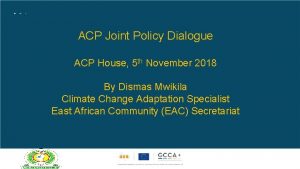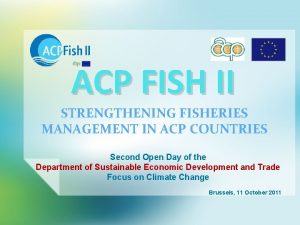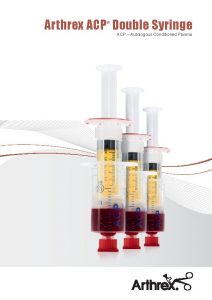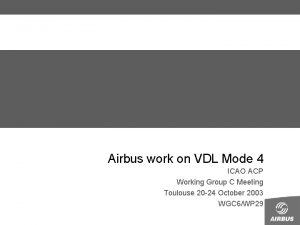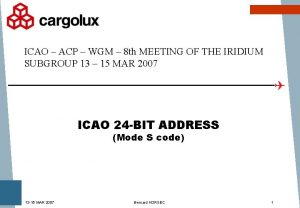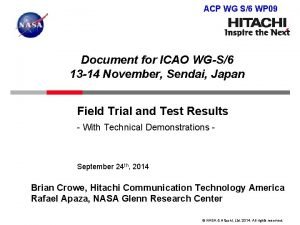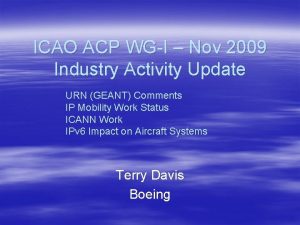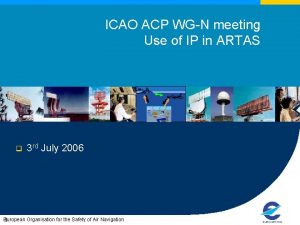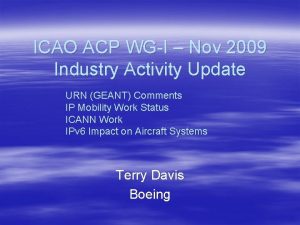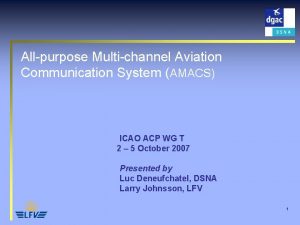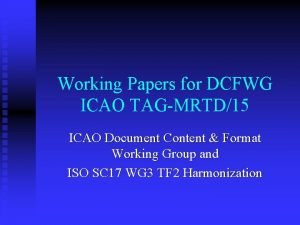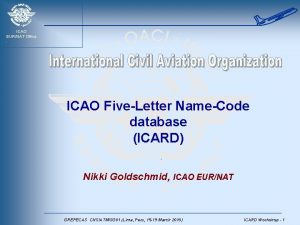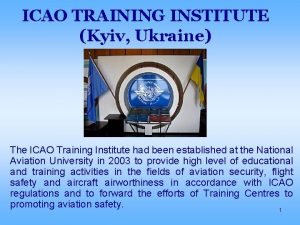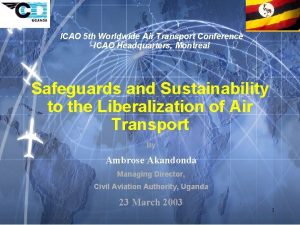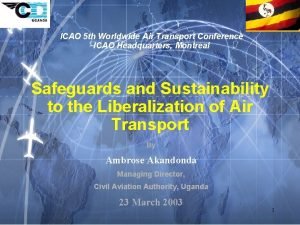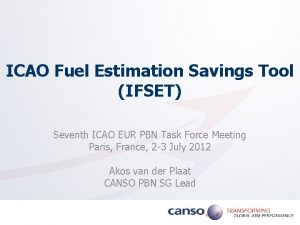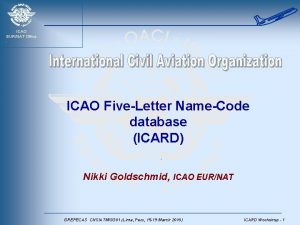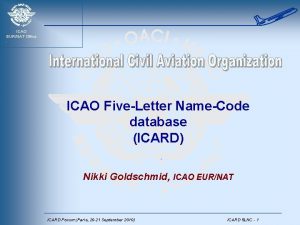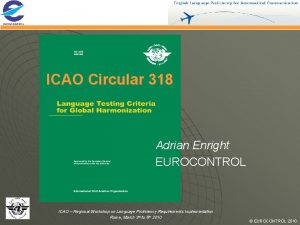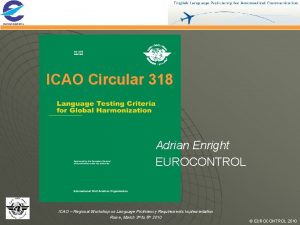Communications Operating Concept Requirements COCR ICAO ACP WGT
























- Slides: 24

Communications Operating Concept & Requirements (COCR) ICAO ACP WG-T Montreal 2 - 5 October 2007 Gregg Anderson - FAA Danny van Roosbroek - EUROCONTROL 11/24/2020 1

Outline • • 11/24/2020 Purpose of the COCR Development of Version 2. 0 Common Evaluation Scenarios Conclusions 2

Aircraft Traffic Communications A Day in 2025 11/24/2020 • More than double today’s traffic • T -Throughput • Advanced ATC concept • C - Continuity • Data is Primary • I - Integrity • … • A - Availability 3

COCR development • Joint EUROCONTROL/FAA activity through common team • Based on potential operational scenarios available at the time in medium and long term – Phase 1 – to 2020 – Phase 2 – 2020+ – Paradigm shift between Phases when data communications becomes the ‘normal’ means of communication • Future radio system is aimed at supporting the Phase 2 requirements – Primarily for data communication • COCR carried out an analysis to support these requirements in various phases of flight 11/24/2020 4

Overview of the COCR (1/3) • Captures the operational requirements for Phase 1 (from now to 2020) and Phase 2 (beyond 2020) – Concept in Phase 1 is drawn largely from available material at the time i. e. the EUROCONTROL ATM concept document for 2008 -11 & 2020 and beyond – Concepts in Phase 2 are based on more extensive use of Phase 1 services and more advanced operations (e. g. 4 D Trajectory Management) • Autonomous operations take place in some parts of the airspace • Based on postulated ATS operational concept using existing documentation and extending it into the future • Broadly in-line with SESAR and Next. Gen concepts of operation 11/24/2020 5

Overview of the COCR (2/3) • From the operational concepts, information flows have been identified in representative test volumes of airspace i. e. ‘positions/sectors’ in Airport, TMA, En Route, & Oceanic. – Airport positions & Radar sectors in Phase 1 similar to today – Radar sectors larger in Phase 2, perhaps 2 -3 x. Airport positions pretty much the same as Phase 1 • Covers all ATS and AOC air-to-ground air-to-air voice and data communication – Includes ADS-B and AOC applications • Includes micro-jets & UAV’s (only ATC control element) • Does not include Air Marshall, UAV Command & Control, SWIM, or spacecraft communications 11/24/2020 6

Overview of the COCR (3/3) • Identifies all communication requirements based on safety and security analysis – Availability, continuity, reliability and latency – Requirements are technology independent • Communication requirements are then used in a queuing model for communication loading (b/s per service volume) – Aircraft numbers are grown over time using EUROCONTROL SAAM data in ECAC – MLM in US 11/24/2020 7

Final COCR Version 2. 0 • Final version of the COCR completed in March 07 – – Presented at ACP/1 – Responded to comments received on COCR Version 1. 0 and clarify areas of ambiguity – Ensured satisfactory agreement among stakeholders with some of the more stringent services and the surrounding concept of their use – Captured and defined missing services – Further defined services to ensure a more complete understanding of their operational use – Categorised services into similar safety/operation groups – Assessed the safety and security requirements associated with each group – Assessed the associated performance requirements impact – Used to support the technology assessment 11/24/2020 8

Requirements - capacity 11/24/2020 9

Requirements – Other Qo. S 11/24/2020 10

Requirements –Latency 11/24/2020 11

COCR TMA Sectors 11/24/2020 12

COCR En route Sector 11/24/2020 13

Evaluation Scenarios • Provide a family of generic operational environments based on an extrapolation of the Phase 2 COCR requirements so each expresses the same requirement in different ways • Reinterpretation of COCR requirements expressed in a variety of ways that can be better used during the technology assessment work • This set of scenarios were used in the technology assessment so as to compare results and identify the technologies in an equitable way 11/24/2020 14

Test Volumes 11/24/2020 15

Airport surface • The airport Test Volumes have been defined as: – TV 1. 1 Airport Zone: 10 NM diameter Cylinder including Runway and Tower operations but excludes surface. – TV 1. 2 Airport Surface: 5 NM diameter circle including Clearance/Ramp and Ground components. 5 NM was representative of a large European airport 11/24/2020 16

Core Europe • Concept of Core Regional Test Volumes was introduced: – TV 4. 1 -4. 4 have been redefined as Core Regional TVs – They are representative of a global Large Area Volume (LAV) such as ECAC or NAS. – Designed to formulate a generic large area rather than a specific case – Characterise a large terrestrial coverage area, or large terrestrial area inclusive of surrounding oceanic airspace regions • Core Regional Test Volumes provide a scenario for either TMA or ENR airspace. • Core Regional Test Volume designed for assessment of space based technologies. 11/24/2020 17

Aircraft Traffic Ref. Volume Type TV 1. 1 Airport Zone – 10 NM diameter 26 TV 1. 2 Airport Surface – 5 NM diameter 264 TV 2. 1 TMA Small – 49 x 49 NM 44 TV 2. 2 TMA Large – 75 x 75 NM 53 TV 3. 1 ENR Small – 55 x 55 NM 45 TV 3. 2 ENR Medium – 100 x 100 NM 62 TV 3. 3 ENR Large – 200 x 200 NM 204 TV 3. 4 ENR Super Large 400 x 400 NM 522 TV 4. 1 TV 4. 2 Core Regional FL 050 – FL 245 [TMA] Core Regional FL 245 – FL 450 [ENR] 1733 TV 4. 4 11/24/2020 PIAC 2908 Core Reg + Oceanic FL 050 – FL 245 [TMA] 1753 Core Reg + Oceanic FL 245 – FL 450 [ENR] 3415 • Traffic Growth Predicting tool used • Busy hour in busy day in 2025 (Phase 2 – COCR) • Peak aircraft count chosen for each Test Volume • Aircraft traffic assumed to be uniformly distributed within the test volume. 18

TMA small 11/24/2020 19

TMA large 11/24/2020 20

En route large 11/24/2020 21

En route super large 11/24/2020 22

Conclusions • The COCR has been the basis for evaluating technologies • Evaluation Scenarios have been used to assess technologies against the requirements in an equitable way • The choice of the appropriate scenario was dependent on the technology 11/24/2020 23

Thank You … 11/24/2020 24
 Communication merit badge requirements
Communication merit badge requirements Boy scout communication merit badge
Boy scout communication merit badge Acp credentialing
Acp credentialing Acp pranil gilda
Acp pranil gilda Acp leadernet
Acp leadernet Acp 125 g
Acp 125 g Questionable abutments in fpd
Questionable abutments in fpd Denture classification
Denture classification Butiril acp
Butiril acp Acp in finance
Acp in finance Acp high value care
Acp high value care Acp template
Acp template Acp mining
Acp mining Scan image
Scan image Set_clock_gating_style
Set_clock_gating_style Acp high value care curriculum
Acp high value care curriculum Urp hospital significado
Urp hospital significado Partial denture parts
Partial denture parts Acp 32
Acp 32 Ačp
Ačp Acp journal wise
Acp journal wise Acp programme
Acp programme Acp programme
Acp programme Acp programme
Acp programme Garima tiwari acp delhi police
Garima tiwari acp delhi police

